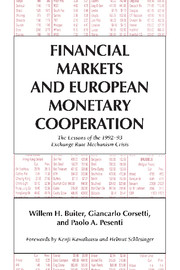 Financial Markets and European Monetary Cooperation
Financial Markets and European Monetary Cooperation Published online by Cambridge University Press: 06 July 2010
The Sanwa Bank established the The Sanwa Research Endowment Found on International Financial Markets at The Center for Japan–U.S. Business and Economic Studies, Leonard N. Stern School of Business, New York University to provide continuing support for research on international economics and financial markets. One of the activities supported by the endowment is an annual financial award to write a monograph based on original research. The first monograph, “International Financial Integration: A study of interest differentials between the major industrial countries,” was written by Richard C. Marston, of the Wharton School of the University of Pennsylvania and published by Cambridge University Press in 1995.
The second award went to Professor Willem Buiter of the University of Cambridge, Giancarlo Corsetti of University of Rome III, and Paolo A. Pesenti of Princeton Univeristy. Each researcher gets two to three years to complete the monograph and three monographs are under preparation.
I am delighted that the second Monograph draws lessons that have much wider relevance than the 1992–93 crisis in European Rate Mechanism. The Bretton Wood System that established a period of considerable stability in exchange rates in the post-World War period ended with the Smithsonian Agreement of 1971. While the relatively higher rate of inflation in the United States made it impossible for many nations to pursue price stability and dollar parity at the same time, it was not clear that the fluctuations in exchange rate that followed were desirable.
To save this book to your Kindle, first ensure [email protected] is added to your Approved Personal Document E-mail List under your Personal Document Settings on the Manage Your Content and Devices page of your Amazon account. Then enter the ‘name’ part of your Kindle email address below. Find out more about saving to your Kindle.
Note you can select to save to either the @free.kindle.com or @kindle.com variations. ‘@free.kindle.com’ emails are free but can only be saved to your device when it is connected to wi-fi. ‘@kindle.com’ emails can be delivered even when you are not connected to wi-fi, but note that service fees apply.
Find out more about the Kindle Personal Document Service.
To save content items to your account, please confirm that you agree to abide by our usage policies. If this is the first time you use this feature, you will be asked to authorise Cambridge Core to connect with your account. Find out more about saving content to Dropbox.
To save content items to your account, please confirm that you agree to abide by our usage policies. If this is the first time you use this feature, you will be asked to authorise Cambridge Core to connect with your account. Find out more about saving content to Google Drive.